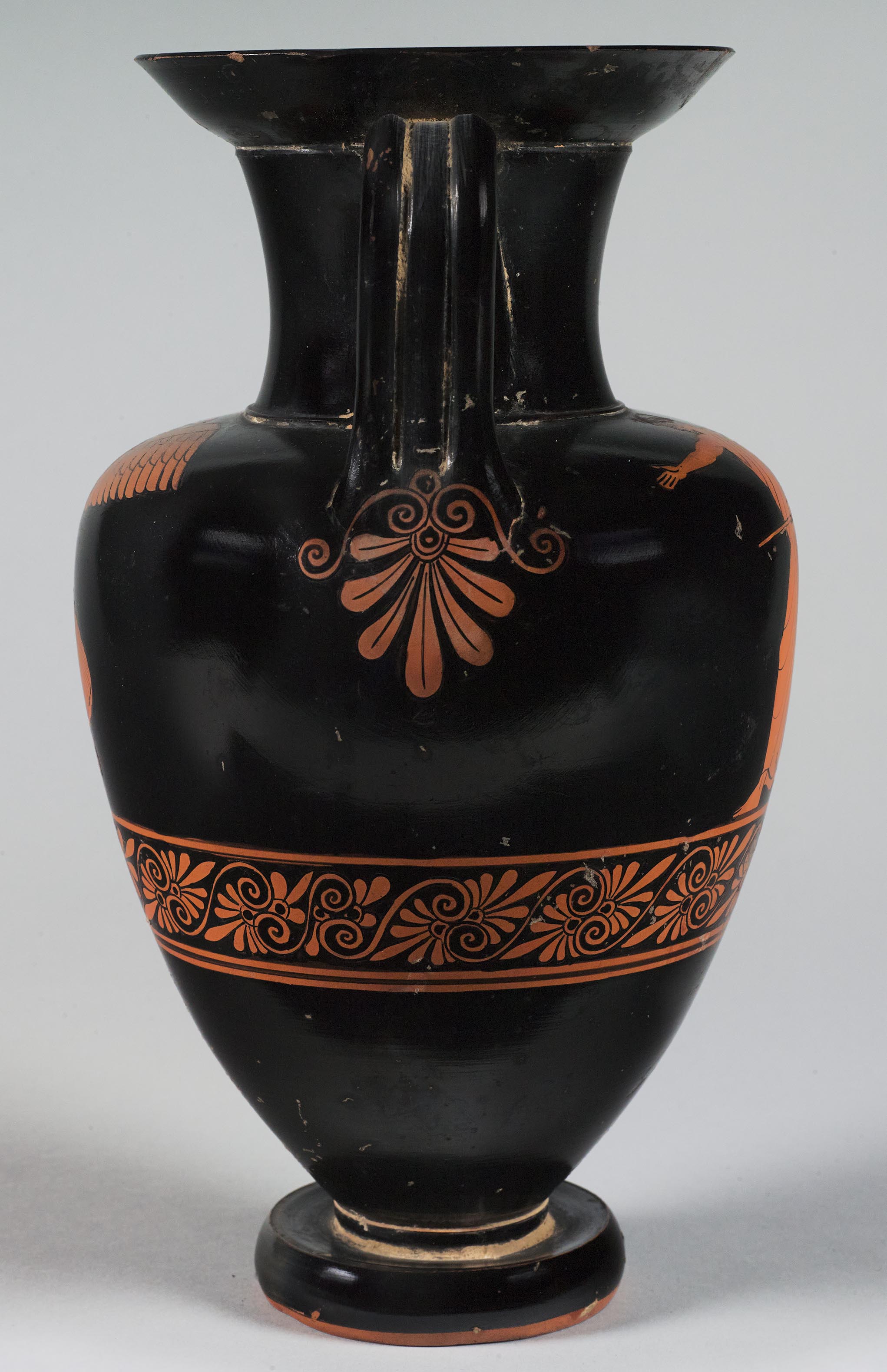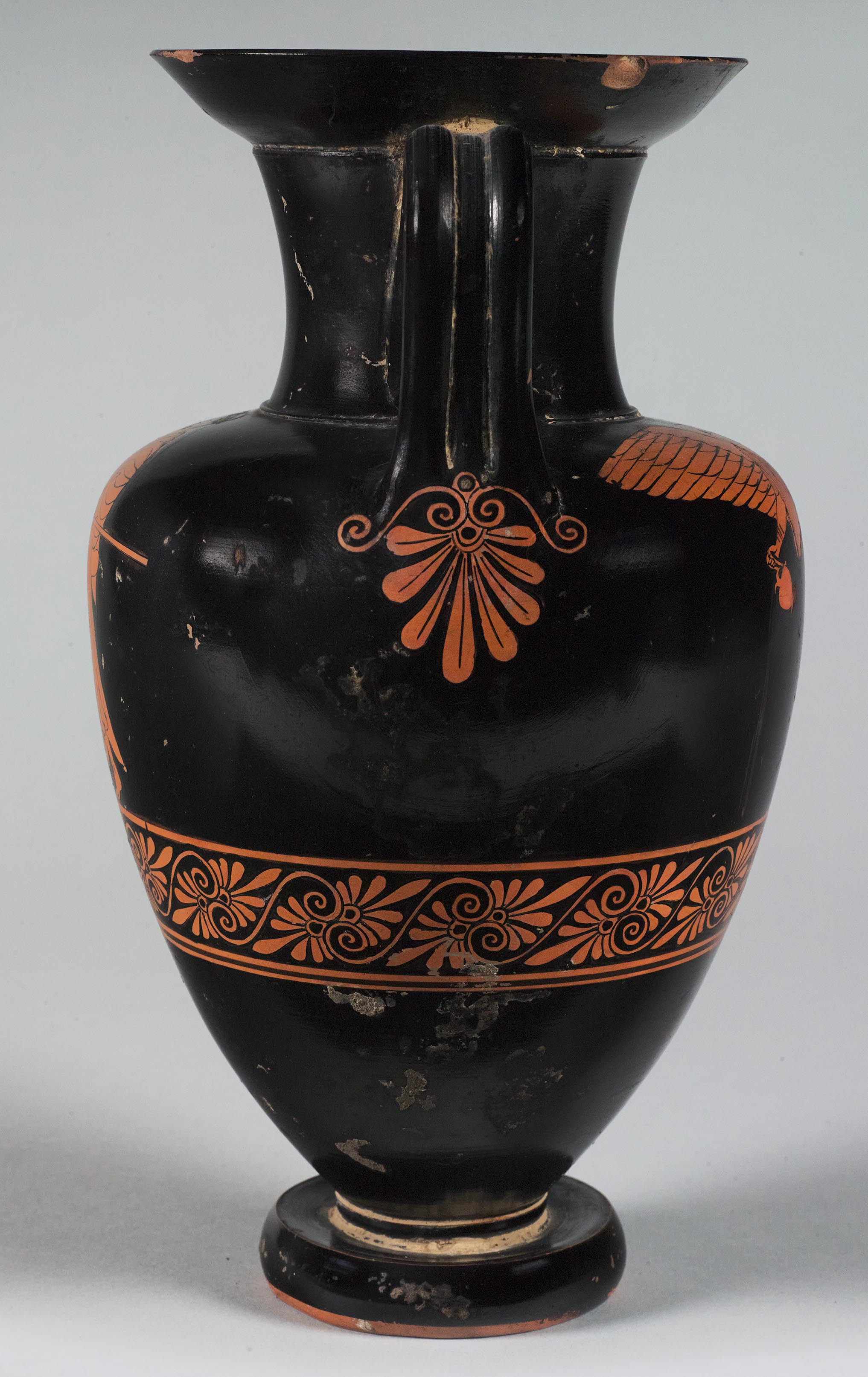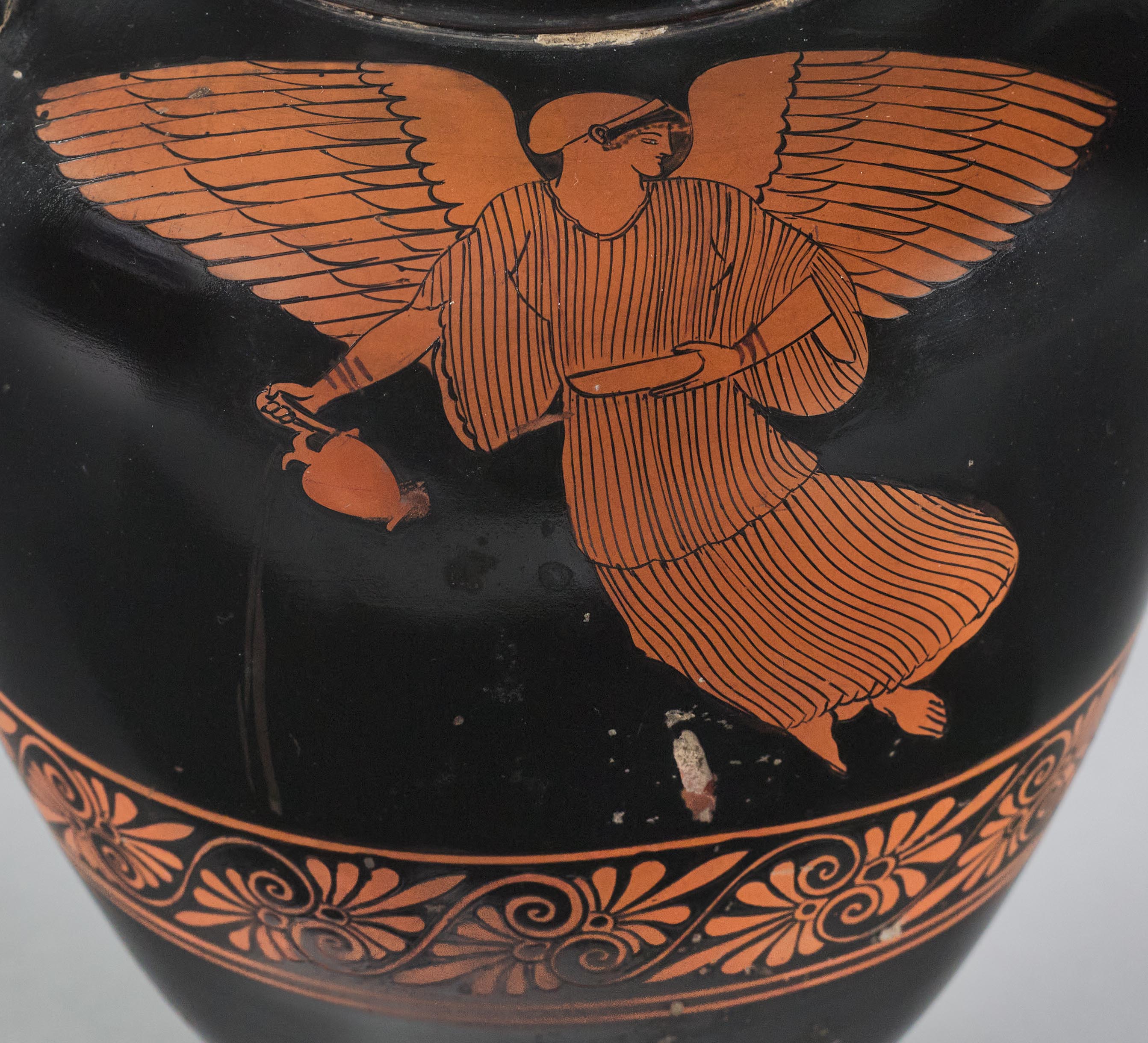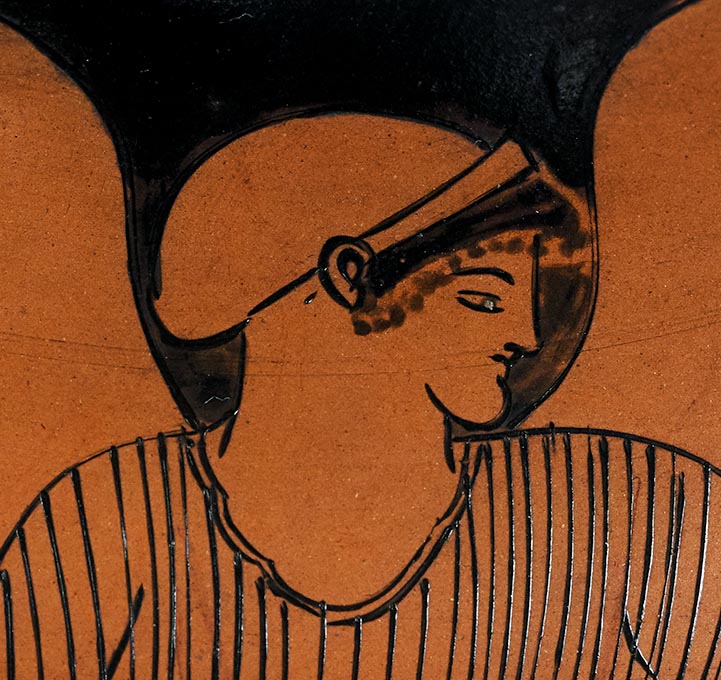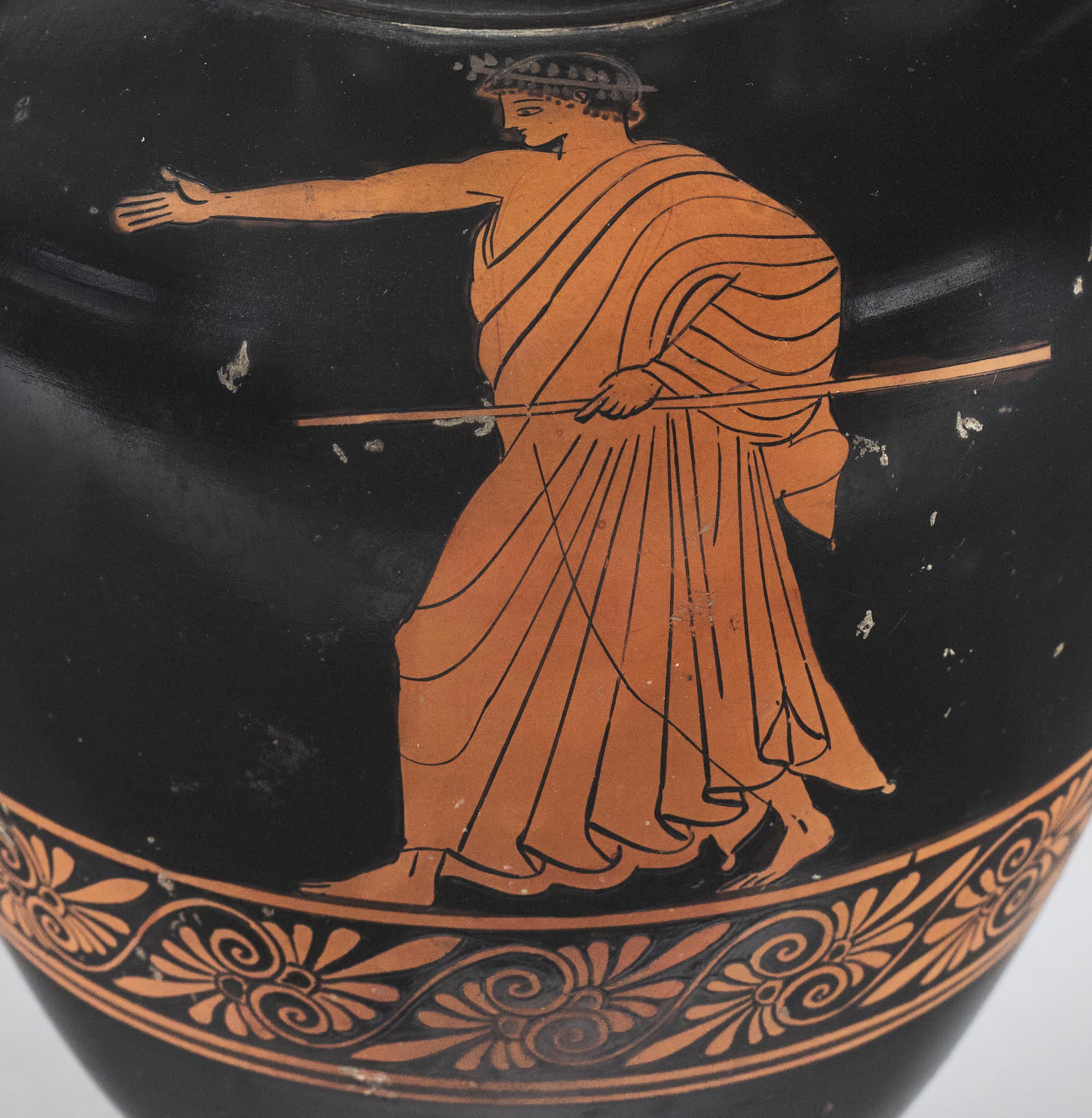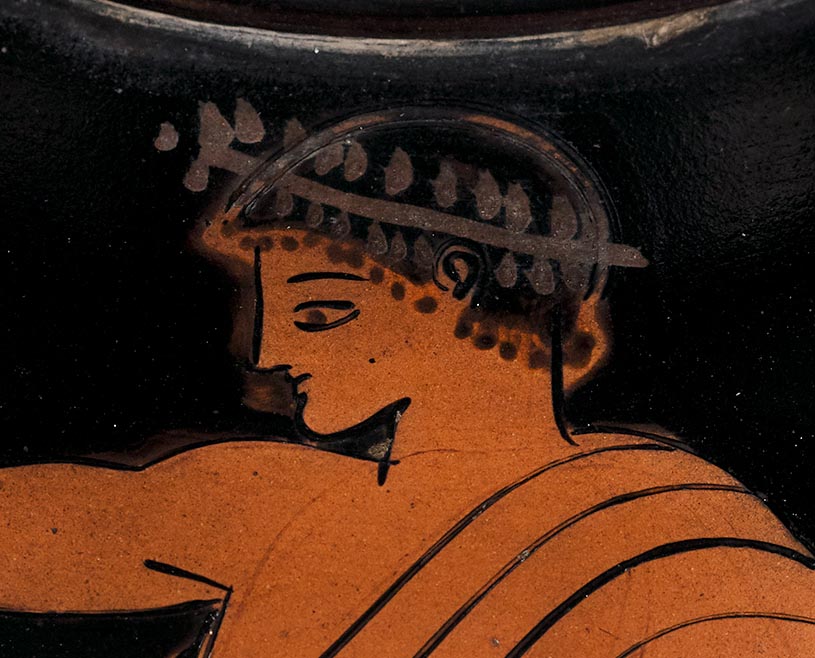Provenance
By 1899, Cornelius Vanderbilt II (New York, NY); 1899–1934, Alice Gwynne Vanderbilt (New York, NY and Newport, RI); 1934–65, Gladys Moore Vanderbilt, Countess Széchényi (Newport, RI); 1965–98, Sylvia Széchényi, Countess Szapáry (Newport, RI); 1926–98, displayed in the library of the Vanderbilt’s Newport summer home, “The Breakers”; 1998–2018, Paul and Gladys Szapáry (New York, NY); 2018, sale, Paul and Gladys Szapáry via Hirschl and Adler Galleries (New York, NY) to Princeton University. An old blue-and-white label on the underside of the foot with an inked numeral “3” has so far not been associated with any known sale or inventory of Greek vases.
Shape and Ornament
Echinus mouth with concave interior, flat on top, black. Notch at join of mouth and neck. Thin ridge at base of neck. Interior of neck black. Triple-reeded handles, black. Beneath each handle, pendant palmette with seven fronds and a black heart with reserved dot at center. Slender body, gently tapering. Encircling band of slanted, addorsed palmettes on lower body, framed by reserved stripe above and two stripes below. Narrow fillet between body and disk foot, framed by incised lines. Upper surface of foot slightly concave; top and sides black; underside reserved.
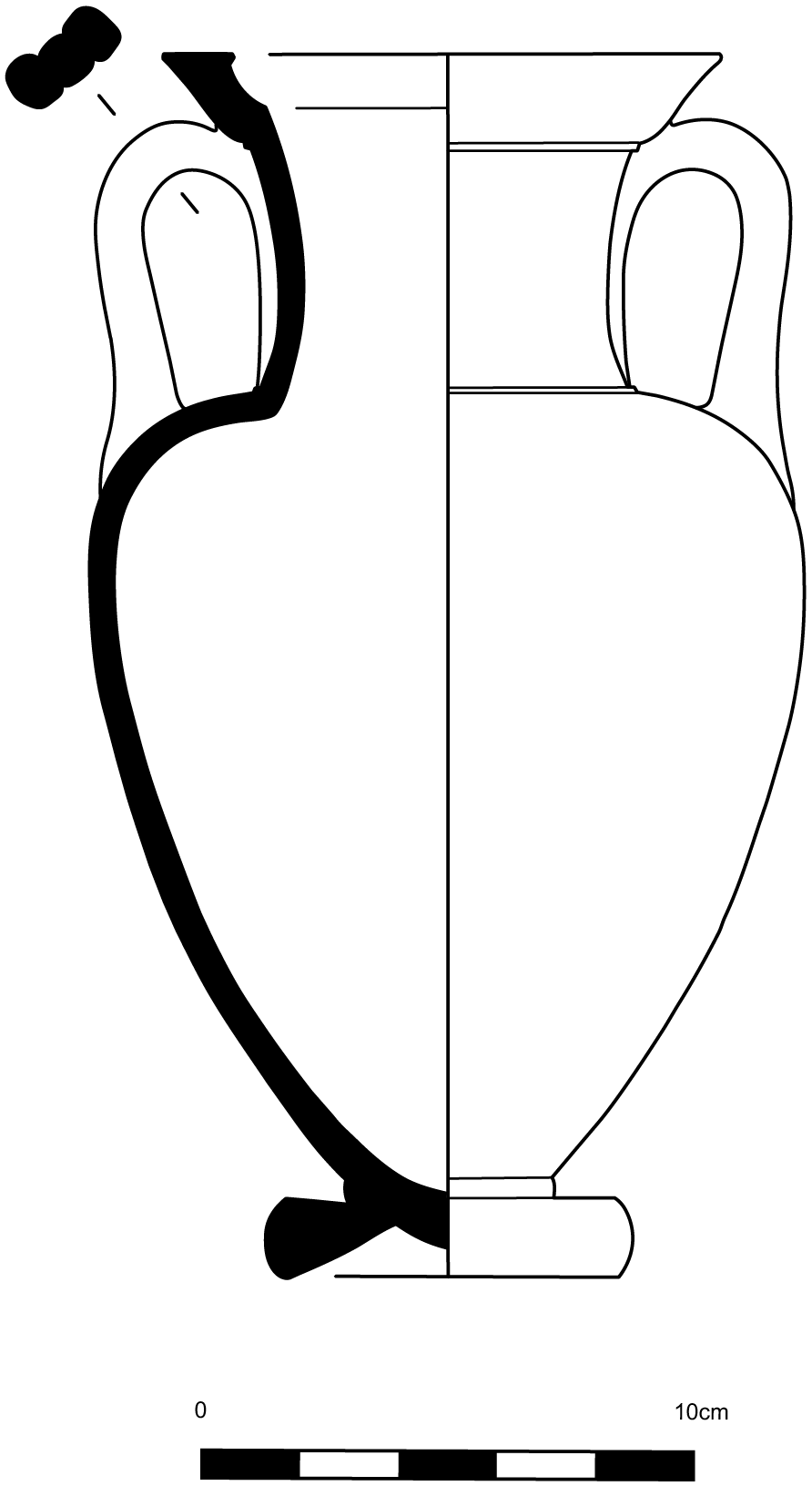
Subject
A. Nike. The winged goddess flies to the left but looks back to the right, her face in profile and her torso frontal. She wears a voluminous, belted chiton that flows behind her and hangs loosely from her elbows. The chiton extends to her ankles, leaving her bare feet exposed, her right foot in profile and her left foot foreshortened. The contours of her breasts, each shown in profile and turned in opposite directions, are clearly visible beneath the heavily pleated garment. Her hair is covered with a sakkos, and she wears red spiral bracelets. The goddess carries a phiale in her left hand and an oinochoe in her right, from which flows a libation of wine, the added red now worn. Her wings, with feathers carefully delineated by relief lines, extend to either side, filling the space between the handles on the shoulder.
B. Youth. The beardless youth moves swiftly in profile to the left, with his legs spread wide. He clutches a walking stick in his left hand, held parallel to the ground at his waist. He wears a heavy himation with dense folds and a red wreath in his short hair. The youth extends his right arm straight before him, perhaps hailing the goddess on side A, who turns her head back in acknowledgment.
Attribution and Date
By a follower of the Berlin Painter. Circa 480–475 BCE.
Dimensions and Condition
h. 24.9 cm; w. 14.6 cm; diam. of mouth 11.4 cm; diam. of foot 7.5 cm. Excellent condition, unbroken. Lustrous black gloss. Small chips in the rim and in several places on the body. Small spots of hard incrustation scattered throughout and a gouge in the surface beneath Nike’s right shin.
Technical Features
Preliminary sketch. Relief contours throughout, except for the youth’s bangs and the hair on the nape of his neck. Accessory color. Red: wine and bracelets on side A; wreath on side B. Dilute gloss: wisps of hair on each figure; pupils.
Bibliography
“Vanderbilt Vases,” Archaeology 46 (1993): 26–27 [illus.]; Abbreviation: BAPDBeazley Archive Pottery Database. http://www.beazley.ox.ac.uk 9038222.
Comparanda
The shape, ornament, and composition, with single figures spotlighted against the dark ground, are broadly typical of Nolan amphorae by the Berlin Painter and his many followers. For the former, see, with bibliography, J. M. Padgett, “The Berlin Painter: As We Know Him,” in Abbreviation: Padgett, Berlin PainterJ. M. Padgett, with contributions by N. T. Arrington et al. The Berlin Painter and His World: Athenian Vase-Painting in the Early Fifth Century B.C. Princeton, 2017, 41–65. For the painter’s followers, see: J. H. Oakley, “Associates and Followers of the Berlin Painter,” in Abbreviation: Padgett, Berlin PainterJ. M. Padgett, with contributions by N. T. Arrington et al. The Berlin Painter and His World: Athenian Vase-Painting in the Early Fifth Century B.C. Princeton, 2017, 66–74; J. Gaunt, “The Berlin Painter and His Potters,” in ibid., 85–106; D. Williams, “Beyond the Berlin Painter: Toward a Workshop View,” in ibid., 151–53. For the band of slanted, addorsed palmettes, cf., by the Berlin Painter, Paris, Louvre G 201 (Abbreviation: ARV2J. D. Beazley. Attic Red-Figure Vase-Painters. 2nd ed. Oxford, 1963 201.63; Abbreviation: BAPDBeazley Archive Pottery Database. http://www.beazley.ox.ac.uk 201871); by the Providence Painter, Harvard 1972.45 (Abbreviation: ARV2J. D. Beazley. Attic Red-Figure Vase-Painters. 2nd ed. Oxford, 1963 638.43; Abbreviation: BAPDBeazley Archive Pottery Database. http://www.beazley.ox.ac.uk 207394); by the Dresden Painter, Paris, Petit Palais 322 (Abbreviation: ARV2J. D. Beazley. Attic Red-Figure Vase-Painters. 2nd ed. Oxford, 1963 656.14; Abbreviation: BAPDBeazley Archive Pottery Database. http://www.beazley.ox.ac.uk 207643). This type of continuous groundline most often is accompanied by a two-figure scene on side A; instead, on this vase, Nike’s wings fill the space otherwise occupied by multiple figures.
At least thirty-five Nikai have been attributed to the Berlin Painter, many with the same accoutrements of oinochoe, phiale, and bracelets. For the stylistic development of the Nike motif in the painter’s work, see C. Isler-Kerényi, “Ein Spätwerk des Berliner Malers,” Abbreviation: AntKAntike Kunst 14 (1971): 27–31. The Berlin Painter, however, prefers to depict Nike with a himation over her chiton: e.g., Harvard 4.1908 (Abbreviation: ARV2J. D. Beazley. Attic Red-Figure Vase-Painters. 2nd ed. Oxford, 1963 211.189; Abbreviation: BAPDBeazley Archive Pottery Database. http://www.beazley.ox.ac.uk 202008); Kassel T 697 (Abbreviation: ParalipomenaJ. D. Beazley. Paralipomena: Additions to Attic Black-Figure Vase-Painters and to Attic Red-Figure Vase-Painters. Oxford, 1971 344.48 bis; Abbreviation: BAPDBeazley Archive Pottery Database. http://www.beazley.ox.ac.uk 352476). The drawing of Nike’s wings on Princeton’s amphora differs also in the detailed use of relief lines for the primary feathers, executed in three overlapping rows. Furthermore, the covert feathers are left blank, rather than the dotted, dilute gloss versions preferred by the Berlin Painter. In fact, the drawing of the chiton and wings on Princeton’s amphora is rather unusual, in particular in the density and thickness of the lines. The chiton finds a less precisely executed parallel, with thinner lines, on an amphora by the Providence Painter: Boulogne 196 (Abbreviation: ARV2J. D. Beazley. Attic Red-Figure Vase-Painters. 2nd ed. Oxford, 1963 638.51; Abbreviation: BAPDBeazley Archive Pottery Database. http://www.beazley.ox.ac.uk 207402). Once again, however, the covert feathers are dotted, while the primary feathers are less detailed in their overlapping, placing them closer to the Berlin Painter than to the artist behind Princeton’s amphora. The latter also shows his skill with the use of thick relief lines on the drapery of the youth, with fold lines spreading out over the entirety of his himation, interrupted only by the horizontal stick.
Both figures have prominent chins, less fully rounded than those typical of the Berlin Painter; small but full lips; straight noses, with little suggestion of nostrils; two slightly arched and unconnected lines for the eyes; and thick necks. The chins recall those of the Eucharides Painter, an early follower of the Berlin Painter, but, among other things, the drawing of the mouths and eyes is completely different. Certain details—thick necks, open-contour eyes, rounded chins, foreshortened feet—recall figures by the Pan Painter, such as the Nike on Zürich 18 (Abbreviation: ARV2J. D. Beazley. Attic Red-Figure Vase-Painters. 2nd ed. Oxford, 1963 553.34; Abbreviation: BAPDBeazley Archive Pottery Database. http://www.beazley.ox.ac.uk 206309), but his eyes are narrower and are combined with expressions of signature sweetness. It has been suggested that the Pan Painter, a frequent painter of Nolan amphorae, was trained in the Berlin Painter’s workshop, for which see C. Sourvinou-Inwood, “Who was the Teacher of the Pan Painter?” Abbreviation: JHSJournal of Hellenic Studies 95 (1975): 107–21; A. C. Smith, “The Evolution of the Pan Painter’s Artistic Style,” Abbreviation: HesperiaHesperia: The Journal of the American School of Classical Studies at Athens 75 (2006): 435–51. The Pan Painter also frequently depicted Nike, although, like the Berlin Painter, he routinely provides her with a himation: in addition to the amphora in Zürich (supra), cf. Providence 35.708 (Abbreviation: ARV2J. D. Beazley. Attic Red-Figure Vase-Painters. 2nd ed. Oxford, 1963 556.105; Abbreviation: BAPDBeazley Archive Pottery Database. http://www.beazley.ox.ac.uk 206348); and Oxford AN 1881.1401 (Abbreviation: ARV2J. D. Beazley. Attic Red-Figure Vase-Painters. 2nd ed. Oxford, 1963 556.102; Abbreviation: BAPDBeazley Archive Pottery Database. http://www.beazley.ox.ac.uk 206345), both of which feature foreshortened feet that recall the left foot of Nike on Princeton’s amphora.
For Nolan amphorae of the Berlin Painter and his followers, see J. D. Beazley, “The Master of the Eucharides-Stamnos in Copenhagen,” Abbreviation: BSABritish School at Athens Annual 18 (1912): 217–24; H. Bloesch, “Ein Meisterwerk der Töpferei,” Abbreviation: AntKAntike Kunst 5 (1962): 18–29; H. Euwe, “The Shape of a Nolan Amphora in Otterlo,” in Enthousiasmos: Essays on Greek and Related Pottery Presented to J. M. Hemelrijk, eds. H. A. G. Brijder, A. A. Drukker, and C. W. Neeft (Amsterdam, 1986), 141–45; id., “The Shape of the Early Nolan Amphorae (490–480 BC): The Origin and the Relation with Other Small Neck-Amphorae,” in Proceedings of the 3rd Symposium on Ancient Greek and Related Pottery, ed. J. Christiansen and T. Melander (Copenhagen, 1988), 144–51; id., “The Nolan Amphorae in Dutch Collections and Their Potters,” Abbreviation: BABeschBulletin antieke beschaving. Annual Papers on Classical Archaeology 64 (1989): 114–33; Abbreviation: Oakley, Achilles PainterOakley, J. H. 1997. The Achilles Painter. Mainz: Philipp von Zabern., 78–80. The sunken upper side of the torus foot, the triple-reeded handles, the sharp echinus mouth, and its overall height place Princeton’s amphora in Euwe’s developed phase of the shape, between 480 and 460: Euwe, “The Shape of a Nolan,” 142. An amphora in Naples (Naples H 3137 [Abbreviation: ARV2J. D. Beazley. Attic Red-Figure Vase-Painters. 2nd ed. Oxford, 1963 201.62; Euwe, “The Shape of the Early Nolan Amphorae,” 146, fig. 3; Abbreviation: BAPDBeazley Archive Pottery Database. http://www.beazley.ox.ac.uk 201870]) is the only Nolan with triple-reeded handles by the Berlin Painter under 30 cm, with the larger examples primarily potted by the A Potter, for whom see Abbreviation: Oakley, Achilles PainterOakley, J. H. 1997. The Achilles Painter. Mainz: Philipp von Zabern., 74, 78–80. Small Nolan amphorae (under 30 cm) are very rare in the first several decades of the fifth century and don’t become popular until after 455, predominantly in the work of the Painter of London E 342. The potting of these later amphorae is careless and should be kept separate from the earlier small Nolans (cf. Princeton 1997-67 [Entry 4]). In his study of early Nolan amphorae, Euwe (“The Shape of the Early Nolan Amphorae,” 145) identified an unnamed potter of very small Nolans (23–25 cm). Within Euwe’s group, cf., by the Pan Painter, Taranto 54384 (Abbreviation: ARV2J. D. Beazley. Attic Red-Figure Vase-Painters. 2nd ed. Oxford, 1963 553.35, 1706; Abbreviation: BAPDBeazley Archive Pottery Database. http://www.beazley.ox.ac.uk 206310), which features Nike; and the sole example by the Berlin Painter, Naples H 3137 (supra), which has similar slanted palmettes. Princeton’s Nolan should perhaps be added to this unnamed potter’s small oeuvre. For a recent general overview of the potters in the Berlin Painter’s workshop, see Gaunt, “The Berlin Painter and His Potters,” 85–106.
The Berlin Painter sometimes depicted Nike flying toward a draped youth with a staff, presumably a victor in an athletic or musical contest: e.g., Paris, Louvre G 198 (Abbreviation: ARV2J. D. Beazley. Attic Red-Figure Vase-Painters. 2nd ed. Oxford, 1963 199.31; Abbreviation: BAPDBeazley Archive Pottery Database. http://www.beazley.ox.ac.uk 201839); Berlin 1965.5 (Abbreviation: ParalipomenaJ. D. Beazley. Paralipomena: Additions to Attic Black-Figure Vase-Painters and to Attic Red-Figure Vase-Painters. Oxford, 1971 345.184 bis; Abbreviation: Padgett, Berlin PainterJ. M. Padgett, with contributions by N. T. Arrington et al. The Berlin Painter and His World: Athenian Vase-Painting in the Early Fifth Century B.C. Princeton, 2017, 262–63, no. 26; Abbreviation: BAPDBeazley Archive Pottery Database. http://www.beazley.ox.ac.uk 352486). The gesture of the youth on side B suggests a connection between the two sides. Instead of directly interacting with the youth, however, the Nike on Princeton’s amphora flies away, acknowledging his presence only through the turn of her head. She thus most likely does not offer a libation in honor of the young man’s victory, but rather pours the liquid as an act of generalized, undirected piety. For this interpretation of libating Nikai, see C. Thöne, Ikonographische Studien zu Nike im 5. Jahrhundert v. Chr.: Untersuchungen zur Wirkungsweise und Wesenart (Heidelberg, 1999), 37–39. For the prominence of Nikai in the works of the Berlin Painter and his followers, perhaps due to the Persian Wars or a particular interest in the competitions of the Panathenaic Festival, see Thöne, Ikonographische Studien zu Nike, 34–35; J. Neils, “Athens in the Time of the Berlin Painter,” in Abbreviation: Padgett, Berlin PainterJ. M. Padgett, with contributions by N. T. Arrington et al. The Berlin Painter and His World: Athenian Vase-Painting in the Early Fifth Century B.C. Princeton, 2017, 12. The Princeton Nike pours a libation directly from an oinochoe; this is not unusual, but it is curious that she also holds a phiale, which she ignores: cf., by the Pan Painter, Providence 56.062 (Abbreviation: ARV2J. D. Beazley. Attic Red-Figure Vase-Painters. 2nd ed. Oxford, 1963 556.106; Abbreviation: BAPDBeazley Archive Pottery Database. http://www.beazley.ox.ac.uk 206349). Unlike Princeton’s amphora, however, on the amphora in Providence no liquid flows directly from the oinochoe, which is the more common scheme for Nikai who hold both an oinochoe and a phiale. The absence of an altar is, again, not unprecedented: see G. Ekroth, “Why (Not) Paint an Altar? A Study of Where, When and Why Altars Appear on Attic Red-Figure Vases,” in The World of Greek Vases, ed. V. Nørskov et al. (Rome, 2009), 89–114. For the possible contexts of libating Nikai, see Abbreviation: Smith, Religion in the ArtSmith, T. J. 2021. Religion in the Art of Archaic and Classical Greece. Philadelphia: University of Pennsylvania Press., 69–70, 75–76.


